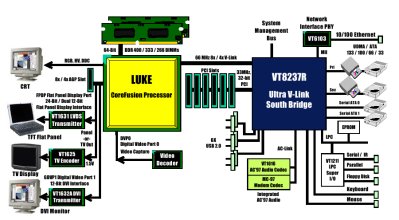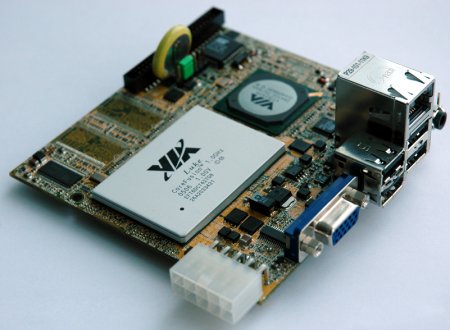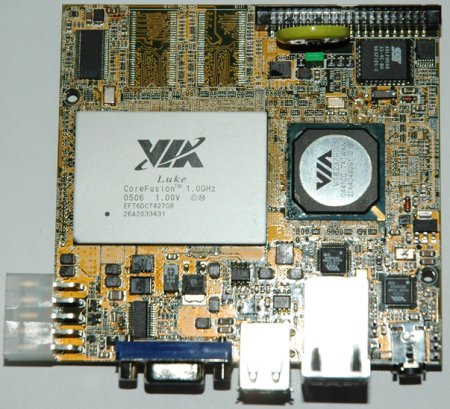Via aims new PC-on-a-chip at “x86 everywhere”
Mar 7, 2005 — by Henry Kingman — from the LinuxDevices Archive — views Via has launched a new chip family it hopes will help the x86 architecture scale into smaller devices with lower power requirements. The CoreFusion family initially includes a pair of two-chip-PC chipsets — each implementing the core functions of a complete PC-compatible system — with a one-chip-PC product due later this year. The chips target “Flat Panel Lifestyle” products that can benefit from compatibility with the PC architecture, such as flat-panel TVs, set-top boxes (STBs), and personal electronics devices such as portable media players.
Via has launched a new chip family it hopes will help the x86 architecture scale into smaller devices with lower power requirements. The CoreFusion family initially includes a pair of two-chip-PC chipsets — each implementing the core functions of a complete PC-compatible system — with a one-chip-PC product due later this year. The chips target “Flat Panel Lifestyle” products that can benefit from compatibility with the PC architecture, such as flat-panel TVs, set-top boxes (STBs), and personal electronics devices such as portable media players.
(Click for larger view of CoreFusion demo board)
According to Product Manager Epan Wu, Via's CoreFusion initiative will allow x86 to extend into handheld, battery powered devices such as tablet PCs and portable media centers.
The two chips sampling this March are codenamed “Mark” and “Luke,” and are based on an embedded Eden CPU core available at clockspeeds up to 1GHz, explained Wu. Both can be paired with Via's southbridge chips to round out the chipset's PC architecture functionality. According to Wu, both chipsets reduce board space requirements by 15 percent, making them suitable for LCD TVs, car entertainment systems, ultra-portable notebooks, and intelligent displays. Both chips are offered with a five-year production guarantee. Additionally, Wu noted that Via's new PC-on-a-chip products support all of the same operating systems as the company's current x86 CPUs and associated northbridge/southbridge chipsets, including desktop and embedded versions of Linux and Windows.
“That's how you go to x86 everywhere,” said Wu.
The lower-end “Mark” chip combines the embedded Eden core with the older Via CLE266 Northbridge found in myriad Via Mini-ITX motherboards. One interesting feature of Mark is the presence of an ISA bus — quite a rarity these days — which Via says is still required in numerous industrial and embedded applications.
The higher-end “Luke” chip combines the embedded Eden core with the newest Via northbridge, the CN400, which supports DDR 400 memory. Among other functions, Luke integrates graphics controller technologies derived from the S3 Graphics UniChrome Pro IGP chip. It features a 2D/3D AGP8X graphics core, with integrated MPEG-2 decoding and MPEG-4 acceleration.

Luke CoreFusion SoC architecture
(Click to enlarge)
Luke supports LVDS output for flat panel displays, DVI for LCD monitors, TV-out, and CRT displays, according to Via. It can be combined with one of three Via southbridge chips, including the VT8235M, VT8237R, or the upcoming VT8251, which offer advanced features such as Fast Ethernet, USB 2.0, ATA-133, Serial ATA, and six-channel surround sound.
“People complained about the small screens in the first generation of portable media centers. Larger screens will bring better batteries that open the door to x86,” which opens up opportunities for the power requirements of Via's CoreFusion PC-on-a-chip SoCs explained Wu.
Via lists maximum power requirements for Luke as follows:
- 1GHz — 10 watts
- 800MHz — 8 watts
- 533 — 6 watts
Power requirements will drop significantly in mid-2005, according to Wu, when die-shrinks based on a 90nm process arrive. At that time, a 1GHz part is expected to have a max power requirement of 3.5 Watts, according to Wu, while a 433MHz part would draw a maximum of 1 Watt. Additionally, aggressive power management should support minimum power draws as low as 100 to 200 mW, Wu said.
Because the new CoreFusion chips are based on mature cores, they also support Via extras such as the PadLock Ace encryption suite, PadLock SDK (software development kit), optimized Xine player, and TruDelete data scrubber.
Luke CoreFusion SoC demo board

Via demo board based on Luke CoreFusion SoC
(Click to enlarge)
According to Via, the 3.9 x 3.9 inch (10 x 10cm) board depicted was produced to show off the kind of low system footprint the CoreFusion products could achieve.

Another photo of the Via demo board based on Luke CoreFusion SoC
(Click to enlarge)
Although Wu said that Via has no plans to mass-produce the Luke demo board, the well-known mini-ITX form factor also began as a demonstration form factor.
For further interesting perspective on the strategies and technologies behind Via's CoreFusion announcement, be sure to read our interview with Glenn Henry, who founded Via's Centaur processor division. In that interview, Henry says that integration is central to the semiconductor industry, and he calls the processor a “black hole” that all PC chips will fall into eventually.
This article was originally published on LinuxDevices.com and has been donated to the open source community by QuinStreet Inc. Please visit LinuxToday.com for up-to-date news and articles about Linux and open source.